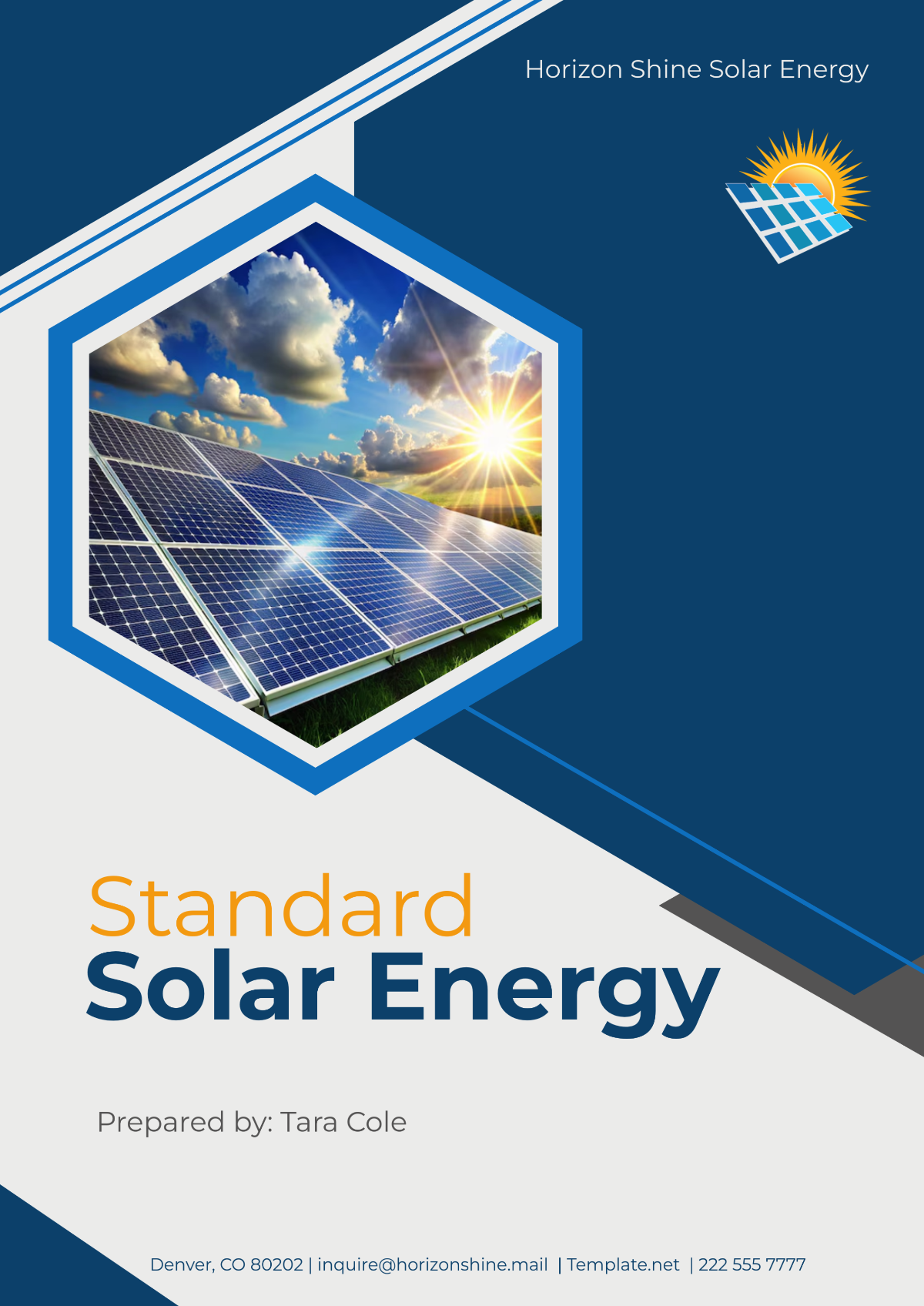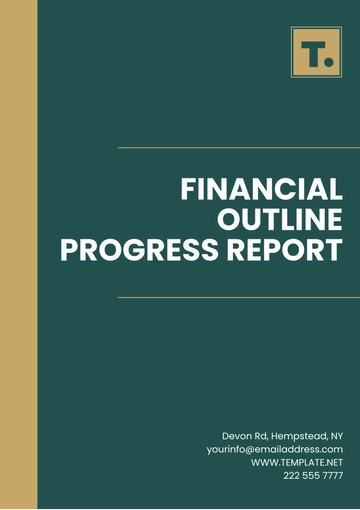Free Solar Energy Report

I. Executive Summary
Solar energy has become a major player in the global energy sector by the year 2060. Due to increasing environmental concerns, governmental incentives, and technological advancements, solar energy now represents one of the most cost-effective and sustainable energy solutions. This report by [Your Company Name] provides an in-depth analysis of the current state of solar energy, future projections, the financial implications, and key areas of growth for investors and governments alike.
The key findings from this report are:
The global installed solar power capacity has reached [1,200] GW, with projections of reaching [2,500] GW by the year 2060.
Solar energy has reduced global carbon emissions by [20%], contributing significantly to climate change mitigation efforts.
Technological advancements in solar photovoltaic (PV) panels, energy storage, and grid integration have decreased the Levelized Cost of Energy (LCOE) for solar power to as low as $[0.03]/kWh in optimal conditions.
This report emphasizes the increasing relevance of solar energy in the global energy mix and explores its potential for shaping the energy market over the next decades.
II. Introduction
A. Purpose of the Report
The purpose of this report is to provide a comprehensive overview of the solar energy industry, its development trajectory, and the future outlook. It aims to shed light on the underlying factors driving solar energy adoption, including economic, environmental, and technological considerations. This report will explore the growth in capacity, financial implications, and technological advances that are shaping the future of solar energy. The findings will serve as a resource for policymakers, energy investors, businesses, and stakeholders in renewable energy, helping them make informed decisions based on current trends and future projections.
B. Scope
This report covers the following areas:
Solar energy market analysis from 2050 onwards: A detailed examination of market dynamics, including growth rates and geographic distribution.
Technological advancements in solar power generation and storage: Insights into the latest innovations that are enhancing efficiency and reliability.
Financial considerations including costs, benefits, and investment opportunities: A thorough analysis of the economic factors influencing solar energy adoption.
Global and regional policies promoting solar energy: An exploration of government actions that facilitate solar development and investment.
Challenges and barriers to solar energy adoption: A discussion on the obstacles that must be addressed to fully realize solar energy’s potential.
III. Global Solar Energy Market Overview
A. Solar Power Capacity and Growth
1. Historical Growth
Solar energy has grown exponentially since its introduction in the late 20th century. By 2060, global solar energy production capacity has reached [1,200] GW, representing an annual growth rate of [8%] since 2050. This growth can be attributed to various interrelated factors:
Decreasing costs of solar PV panels: Significant advancements in manufacturing technologies and materials science have led to reduced prices. For instance, the cost of solar panels has plummeted from around $[3]/W in the early 2010s to approximately $[0.50]/W by 2060.
Increasing governmental support: Governments worldwide have recognized the importance of transitioning to renewable energy sources. Incentives, such as tax credits, rebates, and grants, have facilitated solar installations across residential, commercial, and utility-scale projects.
Global awareness of climate change: Public consciousness about climate issues has catalyzed demands for cleaner energy sources. As nations strive to meet their carbon reduction commitments, solar energy emerges as a pivotal solution.
Year | Global Installed Capacity (GW) | Annual Growth Rate (%) |
|---|---|---|
2050 | [750] | [7.5] |
2055 | [1,000] | [8.0] |
2060 | [1,200] | [8.0] |
2. Future Projections
Future projections indicate that solar energy capacity will continue to rise significantly. By 2060, the total installed capacity is expected to surpass [2,500] GW, driven by both demand and innovation. The International Renewable Energy Agency (IRENA) forecasts that solar energy could supply up to [30%] of global electricity by [2060]. This expansion is anticipated to be particularly robust in developing regions where energy demand is soaring, particularly in countries with abundant sunlight and rising populations.
B. Regional Market Analysis
1. Asia-Pacific
The Asia-Pacific region is the largest market for solar energy, accounting for approximately [45%] of global installed capacity. Countries such as China and India have made substantial investments in solar infrastructure, driven by both population growth and the urgent need to combat pollution.
China: Leading the world with [600] GW of installed capacity by [2050]. China has aggressively invested in solar manufacturing, achieving economies of scale that have reduced costs dramatically. Furthermore, the Chinese government has implemented numerous incentives to encourage both domestic and foreign investments in solar projects.
India: Close behind with a target of achieving [350] GW by 2060. India’s government has set ambitious renewable energy targets, aiming to generate [60%] of its total electricity from non-fossil fuel sources. Initiatives such as the National Solar Mission have accelerated the deployment of solar energy across rural and urban areas alike.
Region | Installed Capacity (GW) | Percentage of Global Capacity (%) |
|---|---|---|
Asia-Pacific | [540] | [45] |
Europe | [360] | [30] |
North America | [180] | [15] |
Rest of the World | [120] | [10] |
2. Europe
Europe has been a pioneer in renewable energy policies, with nations such as Germany, Spain, and the Netherlands adopting aggressive solar energy targets. As of 2055, Europe accounts for [30%] of global solar capacity, with investments focused on integrating solar into the existing grid systems. European countries are also leading the way in creating supportive regulatory frameworks and financing mechanisms that promote the development of solar energy projects. By 2060, Europe aims to achieve full energy independence through renewable sources, establishing itself as a global leader in clean energy technologies.
3. North America
North America, primarily the U.S. and Canada, has seen steady growth in solar installations due to favorable policies, falling technology costs, and public demand for cleaner energy. By 2060, North America holds [15%] of the global solar energy market. The U.S. has implemented a range of incentives, including the Investment Tax Credit (ITC), which allows investors to deduct a significant percentage of the cost of installing a solar energy system from their federal taxes. Canada has similarly introduced policies to support the growth of solar energy in provinces like Ontario and British Columbia, where solar energy capacity has expanded rapidly.
IV. Technological Advancements
A. Photovoltaic (PV) Technology
1. Efficiency Improvements
Solar panel efficiency has significantly improved over the past decades, thanks to innovations in materials and design. In 2060, the average commercial PV panel has an efficiency rate of [35%], a marked improvement from the [15-20%] efficiency seen in the early 2000s. Innovations such as multi-junction cells, which layer multiple semiconductor materials to capture a broader spectrum of sunlight, have made considerable strides. Furthermore, advances in manufacturing techniques have reduced defects in solar cells, further increasing their efficiency and lifespan.
Technology | Efficiency (%) | Commercial Use Year |
|---|---|---|
Monocrystalline Silicon | [20] | [2000] |
Polycrystalline Silicon | [15-17] | [2005] |
Bifacial Panels | [25-30] | [2015] |
Multi-junction Cells | [35] | [2025] |
2. Bifacial Solar Panels
Bifacial solar panels, which capture sunlight from both sides, have gained widespread usage due to their ability to generate up to [25%] more energy compared to traditional panels. These panels are particularly effective in high-albedo environments, such as deserts and snowy areas, where the reflective surfaces can significantly boost energy capture. Their dual-sided design not only increases efficiency but also offers enhanced durability, making them a preferred choice for many new solar projects. By utilizing bifacial technology, projects are seeing quicker returns on investment due to increased energy output without a corresponding increase in land use.
B. Energy Storage Systems
1. Battery Storage
The integration of advanced battery systems has been critical in overcoming the intermittency challenges of solar energy. By 2050, lithium-ion batteries have become more affordable, with costs dropping to $[100]/kWh from $[500]/kWh in 2055. New technologies such as solid-state batteries are being commercialized, offering higher energy densities, faster charging times, and longer lifespans. This advancement enables solar energy to be stored during peak production hours and utilized during high-demand periods, thus enhancing grid reliability.
Battery Type | Cost ($/kWh) | Energy Density (Wh/kg) | Lifecycle (Cycles) |
|---|---|---|---|
Lithium-Ion | [100] | [250-300] | [2,000-5,000] |
Solid-State | [200] | [500-700] | [10,000+] |
Flow Batteries | [300] | [20-40] | [10,000-20,000] |
C. Grid Integration
1. Smart Grid Technology
The development of smart grid technology has transformed how solar energy is integrated into existing power systems. By implementing digital communication technology, grid operators can better manage energy flow, ensuring stability and reliability. Smart grids facilitate two-way communication between energy producers and consumers, allowing for dynamic adjustments based on real-time demand and supply metrics. This flexibility is crucial in accommodating the variable nature of solar energy.
2. Microgrids
Microgrids, localized energy systems that can operate independently or in conjunction with the larger grid, are gaining traction as a solution to energy reliability and security. They provide opportunities for communities to harness local solar energy resources while improving resilience against power outages. By 2060, microgrids powered by solar energy are becoming increasingly popular in both urban and rural areas, as they offer increased energy autonomy and sustainability.
V. Financial Considerations
A. Cost of Solar Energy
1. Levelized Cost of Energy (LCOE)
The LCOE is a critical metric for understanding the financial viability of solar projects. As of [2050], the LCOE for utility-scale solar projects has dropped to $[0.03]/kWh in regions with high solar irradiance. This drastic reduction in cost is attributed to advancements in technology, economies of scale in manufacturing, and improved installation processes.
Year | LCOE ($/kWh) | Technology Type |
|---|---|---|
2050 | [0.15] | Utility-Scale Solar |
2055 | [0.10] | Utility-Scale Solar |
2060 | [0.05] | Utility-Scale Solar |
2065 | [0.03] | Utility-Scale Solar |
2. Financial Incentives
Various financial incentives have been crucial in making solar energy more attractive. Government programs, including tax credits, grants, and rebates, have provided essential support for both residential and commercial solar installations. By 2060, the federal solar tax credit in the U.S. has been extended, allowing investors to deduct [30%] of installation costs from their federal taxes. Such financial mechanisms significantly reduce the upfront costs of solar projects, enabling a broader range of participants to invest in solar energy.
B. Investment Opportunities
1. Venture Capital and Private Equity
Investments in solar technology and infrastructure have attracted substantial venture capital and private equity funding. By 2060, companies focused on developing next-generation solar technologies, energy storage solutions, and smart grid systems have received billions in funding. These investments are crucial for fostering innovation and driving the industry forward.
2. Real Estate Investment Trusts (REITs)
Solar REITs have emerged as an attractive investment option, allowing investors to gain exposure to solar assets without direct ownership. By 2060, the proliferation of solar REITs has made it easier for institutional investors and individuals to diversify their portfolios while contributing to renewable energy deployment. Solar REITs typically invest in utility-scale solar farms, providing consistent income through lease agreements and power purchase agreements (PPAs).
VI. Policy Frameworks
A. Government Incentive
1. Renewable Energy Mandates
Many governments have implemented renewable energy mandates, requiring utilities to source a certain percentage of their energy from renewable sources, including solar. By 2060, such mandates have led to significant increases in solar installations, as utilities seek to meet compliance targets. These policies create a stable market environment that encourages long-term investments in solar energy.
2. Feed-in Tariffs and Power Purchase Agreements
Feed-in tariffs (FiTs) and power purchase agreements (PPAs) have facilitated the growth of solar energy by ensuring that producers receive guaranteed payments for the energy they generate. These financial arrangements provide long-term revenue certainty for solar developers, thus incentivizing new projects. By 2060, numerous countries have adopted these frameworks to stimulate solar energy deployment.
B. International Agreements
1. Paris Agreement
The Paris Agreement has significantly influenced national policies and strategies regarding solar energy adoption. By fostering international cooperation on climate change mitigation, the agreement has encouraged countries to commit to ambitious renewable energy targets, driving investments in solar technologies. The collective effort to limit global warming has created a conducive environment for solar energy growth, leading to widespread governmental support for solar initiatives.
2. Global Renewable Energy Partnerships
Various international organizations and alliances have been formed to promote solar energy deployment across borders. These partnerships aim to share best practices, research, and technological advancements, facilitating the acceleration of solar projects worldwide. Initiatives such as the International Solar Alliance aim to mobilize resources and foster collaboration, enabling developing nations to harness solar energy more effectively.
VII. Challenges and Barriers
A. Grid Integration Issues
1. Infrastructure Limitations
Many regions face significant infrastructure challenges when integrating solar energy into existing grids. Aging grid systems may not be equipped to handle the increased load from renewable sources, necessitating substantial investments in modernization. In regions with limited financial resources, these investments can pose a major barrier to solar adoption. Furthermore, integrating large-scale solar installations often requires new transmission lines and distribution networks, which can take years to develop.
2. Energy Storage Limitations
While energy storage technologies have advanced, there are still limitations related to cost, efficiency, and environmental impact. Although lithium-ion batteries are widely used, their production raises concerns regarding resource extraction and waste management. Additionally, the current capacity of energy storage systems may not be sufficient to meet the needs of regions relying heavily on solar energy, particularly during peak demand periods. Ongoing research is essential to improve storage technologies and reduce costs.
B. Land Use and Environmental Impact
1. Land Requirements
The deployment of solar farms necessitates considerable land use, which can lead to conflicts in densely populated regions or areas with high agricultural value. As the demand for solar energy grows, finding suitable land for large-scale installations becomes increasingly challenging. Strategies must be developed to utilize underutilized spaces, such as rooftops, brownfields, and other marginal lands, to minimize land use conflicts.
2. Environmental Concerns
The environmental impact of solar energy production must be carefully managed. Mining for materials like lithium and rare earth metals used in solar panels and batteries poses significant ecological challenges. Companies must adopt sustainable practices to mitigate the negative effects of extraction and processing. Additionally, strategies should be implemented to recycle solar panels at the end of their lifecycle, minimizing waste and promoting a circular economy.
VIII. Conclusion
Solar energy has established itself as a cornerstone of the global transition toward sustainable energy sources by 2060. With the combination of technological advancements, favorable policies, and rising public demand, solar energy plays a critical role in addressing climate change and meeting energy needs. The industry has reached new heights, and its economic viability has been proven through cost reductions and increased capacity. As we look to the future, solar energy is poised for continued growth and innovation.
However, challenges remain, particularly in grid integration, land use, and environmental impacts. It is essential for stakeholders—governments, investors, and companies—to collaborate in addressing these challenges through policy development, technological advancements, and sustainable practices. By doing so, we can unlock the full potential of solar energy and secure a sustainable energy future for generations to come.
IX. Recommendations
A. For Governments
Invest in Grid Modernization: Governments should prioritize investments in grid infrastructure to facilitate the integration of renewable energy sources, including solar. This modernization will enhance grid reliability and resilience, accommodating the growing share of solar energy in the overall energy mix.
Implement Supportive Policies: To accelerate solar energy adoption, governments should implement policies that encourage investment, such as tax incentives, carbon pricing, and streamlined permitting processes. These measures will create a favorable environment for solar projects, boosting economic growth and job creation.
B. For Investors
Focus on Innovation: Investors should target companies that are leading advancements in photovoltaic technology, energy storage solutions, and smart grid systems. These innovations are likely to drive the next wave of growth in the solar sector and yield significant returns on investment.
Diversify Portfolios: Investing in a mix of solar projects across different regions and technologies can mitigate risk and maximize potential returns. Embracing both utility-scale and distributed generation projects will provide greater opportunities for sustainable growth.
C. For Businesses
Transition to Solar Energy: Companies should consider transitioning to solar energy to reduce operational costs, improve their environmental footprint, and enhance corporate sustainability. Onsite solar installations can significantly lower energy expenses and provide companies with greater energy independence.
Engage in Community Solar Programs: Businesses can participate in community solar initiatives, which allow multiple stakeholders to invest in shared solar installations. This approach not only enhances corporate social responsibility but also provides access to renewable energy for businesses that may not have suitable rooftops or land for solar installations.
- 100% Customizable, free editor
- Access 1 Million+ Templates, photo’s & graphics
- Download or share as a template
- Click and replace photos, graphics, text, backgrounds
- Resize, crop, AI write & more
- Access advanced editor
Evaluate your solar initiatives with the Solar Energy Report Template from Template.net. This editable and customizable template allows you to present key performance metrics, project outcomes, and future recommendations clearly and effectively. Use our Ai Editor Tool to tailor the content to your specific project needs and deliver impactful insights.
You may also like
- Sales Report
- Daily Report
- Project Report
- Business Report
- Weekly Report
- Incident Report
- Annual Report
- Report Layout
- Report Design
- Progress Report
- Marketing Report
- Company Report
- Monthly Report
- Audit Report
- Status Report
- School Report
- Reports Hr
- Management Report
- Project Status Report
- Handover Report
- Health And Safety Report
- Restaurant Report
- Construction Report
- Research Report
- Evaluation Report
- Investigation Report
- Employee Report
- Advertising Report
- Weekly Status Report
- Project Management Report
- Finance Report
- Service Report
- Technical Report
- Meeting Report
- Quarterly Report
- Inspection Report
- Medical Report
- Test Report
- Summary Report
- Inventory Report
- Valuation Report
- Operations Report
- Payroll Report
- Training Report
- Job Report
- Case Report
- Performance Report
- Board Report
- Internal Audit Report
- Student Report
- Monthly Management Report
- Small Business Report
- Accident Report
- Call Center Report
- Activity Report
- IT and Software Report
- Internship Report
- Visit Report
- Product Report
- Book Report
- Property Report
- Recruitment Report
- University Report
- Event Report
- SEO Report
- Conference Report
- Narrative Report
- Nursing Home Report
- Preschool Report
- Call Report
- Customer Report
- Employee Incident Report
- Accomplishment Report
- Social Media Report
- Work From Home Report
- Security Report
- Damage Report
- Quality Report
- Internal Report
- Nurse Report
- Real Estate Report
- Hotel Report
- Equipment Report
- Credit Report
- Field Report
- Non Profit Report
- Maintenance Report
- News Report
- Survey Report
- Executive Report
- Law Firm Report
- Advertising Agency Report
- Interior Design Report
- Travel Agency Report
- Stock Report
- Salon Report
- Bug Report
- Workplace Report
- Action Report
- Investor Report
- Cleaning Services Report
- Consulting Report
- Freelancer Report
- Site Visit Report
- Trip Report
- Classroom Observation Report
- Vehicle Report
- Final Report
- Software Report




























